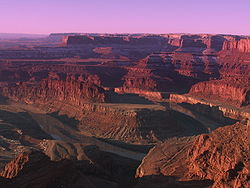Utah State Route 279
| Potash-Lower Colorado Scenic Byway | ||||
 | ||||
| Route information | ||||
| Maintained by UDOT | ||||
| Length | 15.178 mi[1] (24.427 km) | |||
| Existed | 1963[2]–present | |||
| Major junctions | ||||
| South end | Potash mine along Colorado River | |||
| North end | ||||
| Location | ||||
| Country | United States | |||
| State | Utah | |||
| Highway system | ||||
| ||||
| ||||
State Route 279 is a State Highway in the U.S. state of Utah. The highway was constructed in 1962–1963 to service a potash mine and processing plant southwest of Moab. The highway was named one of the most beautiful highways opened to traffic in 1963. The entire length of SR-279 has been designated the Potash – Lower Colorado River Scenic Byway by the Utah State Legislature,[3] however is known locally as Potash Road.[4]
Although the highway was constructed to aid the mining industry of southeastern Utah, the road is popular with tourists and four wheel drive enthusiasts. The jeep trails beginning where SR-279 ends are used to access Canyonlands National Park and Dead Horse Point State Park.
Route description


The highway begins just north of Moab at a junction with U.S. Route 191 near the southern boundary of Arches National Park. The road follows the north bank of the Colorado River to the potash mine. The road is legislatively designated north-south, but actually serpentines for most of its length. The highway loosely parallels a spur of the Denver and Rio Grande Railroad built at the same time and for the same purpose of serving the potash mine. The route of the railroad features a 1.59-mile (2.56 km) tunnel that bypasses most of the serpentine bends in the Colorado River between Moab and the potash plant.[5] While in the Colorado River canyon, the highway passes by dinosaur footprints, indian petroglyphs and jeep trails leading to Canyonlands National Park and Dead Horse Point State Park. The highway also passes by three named natural arches, Corona Arch, Bow Tie Arch, and Jug Handle Arch.[3][4]
History
The highway was first proposed in 1960 as a more direct connection between Moab and Dead Horse Point State Park, which was and is accessed via State Route 313. The proposal followed the north bank of the Colorado River from Moab to a side canyon called Day Canyon. As this point the highway was to depart the Colorado River and ascend the canyon wall to Dead Horse Point.[2] In 1961 the proposal was amended with a second proposed highway, SR-278, to depart from SR-279 at Day Canyon and continue to follow the Colorado River to the potash mine.[6] In 1962 the proposal was amended again, so that SR-279 would continuously follow the Colorado River to the potash mine while SR-278 would be a spur from Day Canyon to Dead Horse Point. State Route 279 was built as per the 1962 version of the proposal. The SR-278 portion of the proposal faced environmentalist opposition and would not be built. A small stub of the proposed route constructed inside Dead Horse Point State Park was added to the legislative designation of SR-313 and the rest of the proposal was withdrawn from the state highway system in 1975.[6]
In 1963, Parade Magazine held the third of an annual competition for most scenic highway that opened to traffic that year. SR-279 was one of four finalists in the competition. The others finalists were I-93 between Windham and Londonderry in New Hampshire, I-84 near Southington, Connecticut and I-405 near Sepulveda Pass in Los Angeles, California.[7][8]
Major intersections
Note: The entire route is located in rural Grand County
| Mile[1] | Junction | Notes |
|---|---|---|
| 0.000 | Potash Plant | Route begins |
| 1.678 | Jug Handle Arch View area | |
| 5.123 | Gold Bar Recreation Area and Campgrounds | |
| 5.294 | Corona Arch/ Bow Tie Arch parking area | |
| 9.390 | Dinosaur Footprints View Area/Poison Spider Mesa Trailhead | |
| 9.726 | Williams Bottom Camping Area | |
| 11.184 | Jaycee Park Recreation Site | |
| 15.178 |
See Also
State Route 128 -- Upper Colorado River Scenic Byway
References
- ^ a b "Highway Description - 00279". Utah Department of Transportation. Retrieved 2008-05-18.
- ^ a b "Route 279". Utah Department of Transportation. Retrieved 2007-12-03.
- ^ a b "Potash/Colorado River Scenic Byway". Utah Office of Tourism.
{{cite web}}: Text "accessdate 2007-08-07" ignored (help) - ^ a b "Scenic Drives in the Moab Area". Moab Area Travel Council. Retrieved 2008-05-18.
- ^ Utah Road and Recreation Atlas (Map). 1:170000. Benchmark Maps. 2002. p. 71. ISBN 0-929591-74-7.
{{cite map}}: Cite has empty unknown parameters:|accessyear=and|accessmonth=(help) - ^ a b "Route 278". Utah Department of Transportation. Retrieved 2007-12-03.
- ^ "America's Prize Wining". Modesto Bee And News-Herald. 1963-10-20.
{{cite news}}: Check date values in:|date=(help) - ^ Mark D. O'Neil. "Scan of 1964 Utah Department of Highways official map". Retrieved 2007-08-13.

